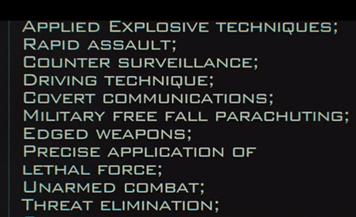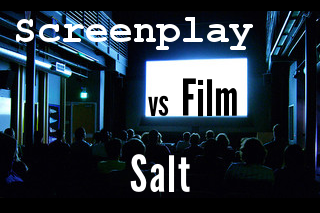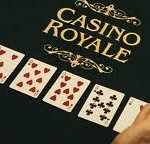The first post in our Writing for Movies: Screenplay vs Film series! One of the best ways to hone your screenwriting skills is to compare a screenplay to its resulting movie. But who has the time for that? Apparently, I do, because I’m going to post the screenwriting tips I learned by doing exactly that. You can find them all here at Screenplay vs Film. And on Thursdays, I’m going to post a list of plot points from that week’s Screenplay vs Film selection. If you analyze these plot points, you should strengthen your understanding of screenwriting structure and pacing.
And now onto my first Screenplay vs Film pick: Salt. Here’s the logline: A CIA agent (Angelina Jolie) goes on the run when a defector accuses her of being a Russian spy. So why did I pick it? I wanted to start off with a fairly recent movie that a good number of readers would have seen. Also, I remembered that Salt’s screenplay was pretty gripping and the movie itself was certainly entertaining (although not on par with the Bourne Identity), so it seemed like a natural choice. Plus, its development history is interesting.
Originally, Tom Cruise was attached to play the lead character, Edwin Salt. He dropped the project, however, because he felt the role was too similar to his Mission: Impossible spy, Ethan Hunt. Instead, he opted to do Knight & Day, which is a candidate for a future Screenplay vs Film post.
When he dropped out, Sony secured Angelina Jolie to play the titular character (and changed Edwin to Evelyn). Apparently, she had been yenning to play a female James Bond for awhile. When I read the screenplay the first time, I thought Cruise would have been PERFECT for the role, so I was highly curious to see how they changed the screenplay to accommodate Angelina.
I was skeptical, but she really did pull it off. Off the top of my head, I can’t think of another female actress who could have done it–and been a box office draw to boot!
The movie was quite different from the screenplay, and not just because of the Tom-Angelina switch. So I learned a lot of screenwriting tips by comparing the two. In fact, I learned so much that I have to divide this post into two to prevent it from being too long. You can find the second part here, 11 Screenwriting Tips from Salt (Part 2).
When I share these tips with you, it might come across like I’m ripping apart Kurt Wimmer’s screenplay.
But I’m not.
Like I said, when I first read the screenplay, I thought it was gripping–I was hooked on whether or not Salt was a Russian spy. I couldn’t turn the pages fast enough–and that’s the most important quality for a screenplay to have.
Only after I compared the screenplay to the movie, did I realize how much tighter the movie was. Kudos go to Wimmer for writing a page-turner and then making it even better.
And now, without further ado, here are the screenwriting tips I learned from comparing the script and film versions of Salt:
Screenwriting Tip #1: Don’t have your plot revolve around a piece of paper
In the screenplay version of Salt that I read, it seemed like its screenwriter, Kurt Wimmer, LOVED paper.
Seriously.
There’s this document, KA-88, that Salt was accused of stealing. And the entire plot of the movie revolved around tracking down Salt in order to recover KA-88.
You can have a screenplay revolve around a piece of paper if that paper has some significance that we can relate to–like the U.S. Constitution or a treasure map (the National Treasure movies do this admirably well). Granted, KA-88 contained important information–a scenario that could cripple the entire US economy. And while the downfall of the American economy is certainly emotionally relevant, it seems so ridiculous that one piece of paper could do that. A piece of paper, no way…greedy Wall Street bankers and their mortgage-backed securities on the other hand…
Because KA-88 comes across as far-fetched, the audience loses its emotional response to the outcome…and we’re wondering why there’s high speed chases and shootouts over a piece of parchment.
The paper also went through a rigorous analysis by CIA experts who are nicknamed the “seven dwarfs.” Here’s the excerpt:
INT. LANGLEY
A CANARY YELLOW pair of latex gloves subjects the RUSSIAN FILE to fluoroscopic penetrative imaging …
A ROBIN’S EGG pair of latex gloves subjects the FILE to comparative materials analysis …
A SKY BLUE pair of latex gloves subjects the FILE to tetracyclaphenamine corrosive detection …
A PEA GREEN pair of latex gloves subjects the FILE to biological residue illumination …
A RUST RED pair of latex gloves subjects the file to fingerprint analysis …
A HOT PINK pair of latex gloves subjects the file to D3 digital deductive decryption …
A JET BLACK pair of latex gloves subjects the file to passive radiative imaging …
Their OWNER, the 7th of the Seven Dwarves of forensic analysis at the Central Intelligence Agency looks up.
He nods.
I love the description of their different colored gloves. It adds a nice touch of humor when reading it, but it doesn’t translate well on the screen. Think about it — it’s a full minute of gloves fondling paper!
In the movie, things improve. There are high speed chases and shootouts to prevent Salt from assassinating the Russian president and also from stealing US nuclear codes. These have a significance we can relate to.
Admittedly, in the screenplay, a part of the plot hinged around assassinating the president-elect — also emotionally significant — but for me, that came in way too late.
Screenwriting Tip #2: If you’re writing an action movie, then let’s see some action!
The first remotely action-y bit in Salt’s screenplay didn’t happen until page 38. 38! That’s one-third of the way through the screenplay — and far too late. Even worse than that, it was voodoo action.
By voodoo action, I mean we didn’t see any of the fight on screen. Well, we see the first part: Salt bites into his torturer’s wrist. And that’s a great start. But it’s followed by:
BANG! the door flies open and HALF A DOZEN more agents burst into the tiny concrete room, GUNS drawn.
JUMPING through his bound wrists, Salt grabs the first man through, tying him into a pretzel of crunching cartilage.
The room is filled with the flash and explosion of gunfire and three seconds later, only one man is left standing.
Edwin A. Salt.
It’s like Salt killed them all with magic, not with skill, and when I read that, I felt cheated. I do want to point out though that this style could’ve worked in a more tongue-in-cheek action movie that’s not taking itself too seriously (like Knight & Day).
In the movie, we get a nice action sequence in which Salt gets barricaded on a CIA storage level and makes a homemade bomb in order to escape a tactical team, which if I recall correctly, has orders to kill her. I should point out that the homemade bomb scene IS in the screenplay, it just occurs too late.
In an action movie, you can never be too soon with an action sequence. In a comedy, you can never be too soon with a joke. Whatever genre you’re writing for, make sure the distinguishing characteristic of that genre pops in early.
Screenwriting Tip #3: Location, location, location!
In the screenplay version of Salt, a key sequence takes place in Philadelphia. I mean no disrespect towards the City of Brotherly Love…but it’s not really a “sexy” city. The same sequence would have a lot more tension (without changing any of the action), if it had been set in D.C. or New York.
Now this key scene involves a speech given by the president-elect of the United States. Perhaps, the president-elect always gives a speech in Philly? I don’t know. Even if that’s true, I think it’s better if you take your screenwriter’s license to change certain facts and have this key speech delivered in D.C.
Now if the speech took place in front of the Liberty Bell, and the Bell is used as part of Salt’s scheme, then by all means, set the scene in Philly. But otherwise, stick with D.C. or New York — which is exactly what the movie did.
Before my observations get misinterpreted, I’m not saying to set every movie you write in these two cities. But if you’re writing a political thriller set in the USA, the best backdrop is D.C. or New York. Just like you’d set a British political thriller in London instead of Liverpool…
Location is important in comedies too, not just thrillers. If you want to see how location choice impacted The Hangover, check out screenwriting tips #3 & #4 in How to Write a Comedy Script: Tips from the Hangover.
Screenwriting Tip #4: If you want us to like the hero, don’t have him kill a dog
This screenwriting tips is a corollary to Blake Snyder’s “save the cat” rule, which is basically: write a scene which gets the audience “in sync” with the main character.
In the screenplay, Wimmer does not “save the cat.” As a matter of fact, he has Salt kill his own dog. Specifically, he breaks its neck. Wimmer follows that with Salt shooting his spy instructor in the head. Salt is only 12 years old.
There’s a lot of debate in screenwriting circles as to whether your main character has to be likeable. I don’t think he has to be likeable, but we do have to care about what happens to him. Melvin Udall in As Good As It Gets is a great example of someone you don’t necessarily like but you’re interested in his story.
In Salt, a lot of the intrigue comes from wondering if Salt is a Russian spy or not. And it’s certainly gripping stuff. But if you know that he killed his own dog barehanded and then shot his teacher, Salt becomes a soulless inhuman, and there’s a high probability that you won’t care whether he’s a good guy or a bad guy.
Screenwriting Tip #5: Demonstrating your hero’s skill set
In the screenplay, Wimmer spends a lot of time on Salt’s backstory and demonstrating his wide range of skills. The only problem is that the backstory slows down the screenplay’s pace and makes the first act too long.
In the movie, they cut out most the of backstory and just show a screenshot of Salt’s CIA résumé (which a character looks at on his phone).

Screenshot of Salt’s Résumé
This wouldn’t be enough if they didn’t follow the screenshot with an action sequence in which Salt demonstrates some of her skills. Plus, later when she demonstrates her unarmed combat skills, we’re not surprised or incredulous. It was the perfect of balance of showing & telling.
Final thoughts
I hope that everyone can’t get enough of these screenwriting tips because I’m going to post the rest of them tomorrow! Also, I’d love to hear your suggestions for screenplays/films to analyze in this Writing for Movies: Screenplay vs. Film series.
Watching a blank screen (with modifications) by Kenneth Lu





















Comments on this entry are closed.
Thank you very much for your screenplay tips. Last year I took the plunge and wrote and submitted my first short screenplay. I was very excited, as I was a finalist, but at that time I really had not realized how much goes into doing a screenplay.
I finally decided to give feature length films a try. And it is now I realize how in the dark -I still am- with screenwriting. But the love of writing and doing screenplays pushes me forward.
Recently, someone has requested I do a feature length screenplay, but as this is so new to me I flounder in many directions with this. But when I read tips, especially as helpful as yours, I feel confident in that direction.
So I thank you very much for your thoughts and wonderful tips on here, and your generosity and your time in doing this for those trying to learn the screenwriting trade.
Hi Veronica,
Thanks for visiting Scribe Meets World! I am so glad that my posts have helped advance your screenwriting knowledge. “Floundering” is all part of the process. If you keep at it, it becomes easier and easier (and hopefully the inner critic becomes quieter and quieter).
I took a visit to your blog, Restless Spirit-Rogue, and I love the post you wrote about your daughter. If you apply that same self-awareness and power of observation to your screenplay, it will certainly be a powerful work.
It’s great that someone has requested you write a feature length screenplay for them. My advice: get a rough draft done as quickly as you can. Don’t worry if it’s full of amateur mistakes. Put it away in a drawer, ideally for at least two weeks. Then take that draft and spend time revising it, according to the tips I’ve written about and ones you’d find in helpful screenwriting books like Save the Cat and Crafty Screenwriting.
Good luck Veronica!
I was almost forced into a situation where I had to write a script- all very strange.
This is a great site. You can never have enough tips on writing.
Thanks for the kind words, Richard! I’m curious about this situation where you were almost forced to write a script…please share more details if you are so inclined!
How about doing Platoon? Incredible screenplay, one of the most visceral ever written as Oliver Stone puts into the action, and you feel you’re right there with him in Vietnam. Blacks have their speech patterns vs the whites. Great script.
Hi Jon,
Thanks for the suggestion. I appreciate it.
I’m not keen on war movies, though, so an analysis of PLATOON is unlikely to appear on the website! (Although I do recognize it is a classic.)